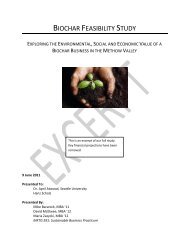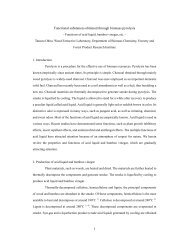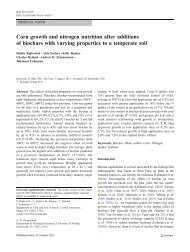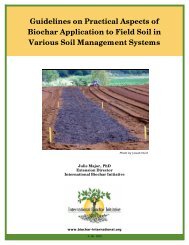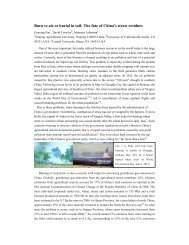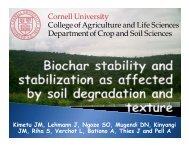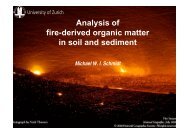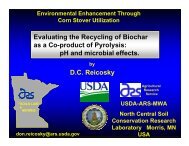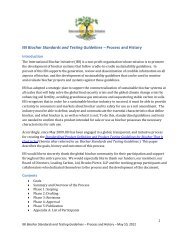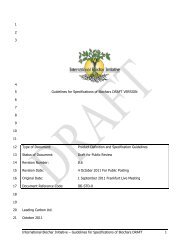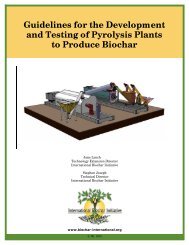Guidelines for Specifications of Biochars for Use in Soils FINAL ...
Guidelines for Specifications of Biochars for Use in Soils FINAL ...
Guidelines for Specifications of Biochars for Use in Soils FINAL ...
Create successful ePaper yourself
Turn your PDF publications into a flip-book with our unique Google optimized e-Paper software.
12345678910111213141516171819202122232425262728296.1 Tim<strong>in</strong>g and Frequency <strong>of</strong> Test<strong>in</strong>gBiochar test<strong>in</strong>g and report<strong>in</strong>g accord<strong>in</strong>g to the Biochar <strong>Guidel<strong>in</strong>es</strong> shall be required:- Annually; or- After every 600 metric tonnes (dry weight) <strong>of</strong> consistent feedstock through-put; or,- After a material change <strong>in</strong> feedstock; 2 or,- After a material change <strong>in</strong> production parameters;whichever is more frequent.Test<strong>in</strong>g <strong>of</strong> biochar materials should occur be<strong>for</strong>e f<strong>in</strong>al storage or shipment. If the material is<strong>in</strong>tended to be mixed with another material, test<strong>in</strong>g <strong>of</strong> the biochar material must occur be<strong>for</strong>emix<strong>in</strong>g or blend<strong>in</strong>g with any other product.6.2 Laboratory StandardsLaboratory analysis <strong>of</strong> biochar shall be conducted by tra<strong>in</strong>ed and accredited laboratorypr<strong>of</strong>essionals follow<strong>in</strong>g the appropriate procedures identified <strong>for</strong> each test. Test<strong>in</strong>g shall followstrict quality control requirements accord<strong>in</strong>g to standardized laboratory procedures. Please referto Appendix 2 <strong>for</strong> further guidance on sampl<strong>in</strong>g procedures and sample process<strong>in</strong>g and handl<strong>in</strong>gprior to analysis.Laboratory pr<strong>of</strong>essionals are expected to be tra<strong>in</strong>ed <strong>in</strong> the relevant field <strong>of</strong> analytical chemistryand operate <strong>in</strong> pr<strong>of</strong>essional laboratories that have received general laboratory accreditation.Such accreditation should be provided by a relevant govern<strong>in</strong>g body such as the localjurisdiction’s government (e.g. Standards Council <strong>of</strong> Canada or the US Compost<strong>in</strong>g Council) oran <strong>in</strong>ternational standards body like the ISO. The <strong>in</strong>tent <strong>of</strong> such laboratory standards is tomake certa<strong>in</strong> that contribut<strong>in</strong>g laboratories will provide reliable and replicable results that willensure that an appropriate standard <strong>of</strong> quality is met.6.3 Cha<strong>in</strong> <strong>of</strong> CustodyCha<strong>in</strong> <strong>of</strong> custody and product traceability will require an assurance that adequate care andtransparency is be<strong>in</strong>g exercised to enable trace-back <strong>of</strong> f<strong>in</strong>al end-products from end usersacross the biochar market to manufacturers and feedstock suppliers. All entities <strong>in</strong> the biocharproduction and supply cha<strong>in</strong> will be required to participate <strong>in</strong> record keep<strong>in</strong>g to ma<strong>in</strong>ta<strong>in</strong> qualityassurance.32 Material changes <strong>in</strong> feedstock reflect shifts <strong>in</strong> feedstock type from one source <strong>of</strong> biomass to a dist<strong>in</strong>ctlydifferent source <strong>of</strong> biomass. See Appendix 4 <strong>for</strong> more <strong>in</strong><strong>for</strong>mation on how to determ<strong>in</strong>e feedstock typesthat constitute a “material change” <strong>in</strong> type. In mixed feedstocks, whether processed or unprocessed, a10% or greater shift <strong>in</strong> total feedstock composition shall constitute a material change <strong>in</strong> feedstock.3 Material changes <strong>in</strong> production processes reflect <strong>in</strong>creases or decreases <strong>in</strong> process temperature (i.e. +/-International Biochar Initiative – <strong>Guidel<strong>in</strong>es</strong> <strong>for</strong> <strong>Specifications</strong> <strong>of</strong> <strong>Biochars</strong> <strong>for</strong> <strong>Use</strong> <strong>in</strong> <strong>Soils</strong> 18



